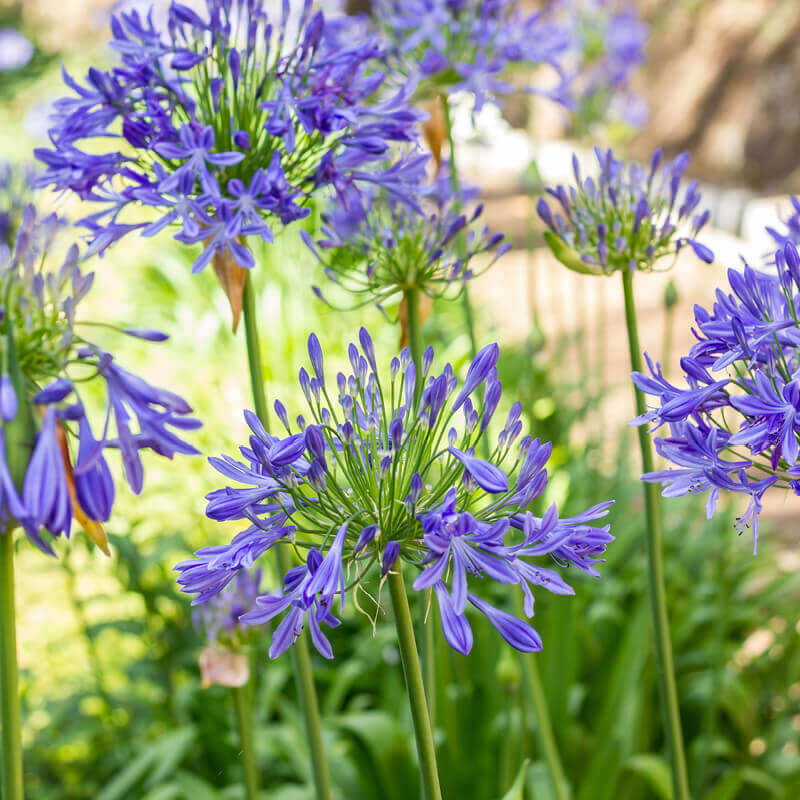Understanding the Art of Agapanthus Treatment: Vital Actions for Healthy Growth and Lively Blossoms
In the realm of horticulture, the growing of agapanthus stands as a fulfilling endeavor for those that seek to nurture these elegant flowering plants. With their striking blooms and stylish foliage, agapanthus has actually recorded the focus of garden enthusiasts worldwide. However, achieving ideal growth and dynamic blossoms needs a nuanced method that incorporates different crucial steps. From choosing the appropriate range to grasping trimming techniques, the journey towards growing growing agapanthus plants is multifaceted and holds the key to unlocking the complete possibility of these botanical treasures.

Choosing the Right Agapanthus Selection

When choosing the ideal Agapanthus range for your garden, take into consideration variables such as climate viability, bloom color, and development behavior. Additionally, consider the environment in your area to make certain the Agapanthus selection you choose can thrive in your particular problems. Recognizing the development behavior of different Agapanthus selections is vital for proper positioning within your garden.
Suitable Growing Conditions
Thinking about the optimum environmental demands is essential for effective Agapanthus growing. Agapanthus grows in well-draining soil with a somewhat acidic to neutral pH degree. When planting, pick a place that receives full sunshine to partial shade. In hotter climates, offering some mid-day color can avoid scorching of the fallen leaves. Agapanthus plants are delicate to cool temperatures and ought to be shielded from frost during winter season.
To make certain healthy and balanced growth and vivid blooms, plant Agapanthus light bulbs at a deepness of regarding 2-4 inches and area them 8-12 inches apart. Mulching around the base of the plants assists keep dampness and subdues weed growth.
Watering and Feeding Tips
Keeping appropriate wetness levels and providing crucial nutrients are crucial elements in the care routine for Agapanthus plants. It is crucial to strike an equilibrium when it comes to watering Agapanthus. These plants favor regularly moist soil however are vulnerable to root rot if overwatered. During the growing period, water deeply as soon as a week, guaranteeing the dirt is well-draining to avoid waterlogging. In hotter environments or during periods of drought, even more frequent watering might be necessary to maintain the soil uniformly moist. Nonetheless, decrease watering in the winter months to stop waterlogged conditions.
Feeding Agapanthus is crucial for advertising healthy and balanced growth and prolific blossoms. Apply a balanced plant food, such as a 10-10-10 formula, in the early springtime as brand-new growth arises. By adhering to these watering and fertilizing ideas, you can ensure your Agapanthus plants flourish and generate vibrant, resilient blossoms.
Pruning Methods for Agapanthus
Trimming Agapanthus plants at the appropriate times and with appropriate methods is crucial for preserving their wellness and advertising optimum development and blooming. The ideal time to prune Agapanthus remains in late winter season or very early springtime prior to new growth emerges. Beginning by removing any kind of yellowing check it out or dead leaves near the base of the plant. Cut them as close to the ground as possible without harming the arising shoots.
For flowered stems, wait up until the blooms have actually withered and after that trim them back to the base. This not just cleans the plant's appearance but likewise encourages the advancement of brand-new blossom buds. Deadheading invested blossoms can likewise redirect the plant's energy into producing even more blooms instead than establishing seeds. However, if you wish to gather seeds for propagation, leave some blossoms to completely dry and mature on the plant.
Bear in mind to use tidy, sharp tools to make specific cuts and decrease the threat of introducing conditions. Agapanthus. Regular trimming will aid maintain your Agapanthus looking neat and healthy while ensuring a bountiful display screen of stunning blooms
Handling Common Bugs and Illness
After making certain correct trimming strategies for Agapanthus, it is vital to address common pests and illness that can influence the wellness and vigor of these plants. Agapanthus plants are generally durable but can still succumb to specific problems. One usual pest that affects Agapanthus is the Agapanthus gall midge. This tiny, orange fly lays its eggs in the vegetation, bring about distorted growth and blossom buds that fail to open. To fight this insect, trim and damage any kind of damaged plant components and consider utilizing insecticidal soap.
Another common concern is fungal fallen leave area, which provides as dark sores on the leaves. To avoid fungal diseases, ensure good air circulation around the plants, stay clear of overhanging watering, and eliminate any contaminated leaves immediately. Additionally, Agapanthus plants can suffer from root rot if they are grown in improperly draining dirt. To stop this, plant Agapanthus in well-draining dirt and prevent overwatering. By being alert and taking prompt activity against pests and conditions, you can aid your Agapanthus plants prosper and create original site vibrant flowers.

Verdict
Finally, mastering the art of agapanthus care includes choosing the best range, offering excellent planting problems, correct watering and feeding, ideal trimming techniques, and dealing with common pests and diseases. By adhering to these necessary actions, you can guarantee healthy development and vivid blooms for your agapanthus plants. Bear in mind to regularly check and keep your plants to promote their general wellness and longevity.
To make certain healthy and balanced growth and vibrant flowers, plant Agapanthus bulbs at a deepness of regarding 2-4 inches and room them 8-12 inches apart. By following these watering and feeding ideas, you can ensure your Agapanthus click now plants grow and generate vivid, durable flowers.
One common parasite that impacts Agapanthus is the Agapanthus gall midge. Furthermore, Agapanthus plants can experience from origin rot if they are grown in inadequately draining dirt. By complying with these necessary steps, you can make certain healthy development and vibrant blossoms for your agapanthus plants.